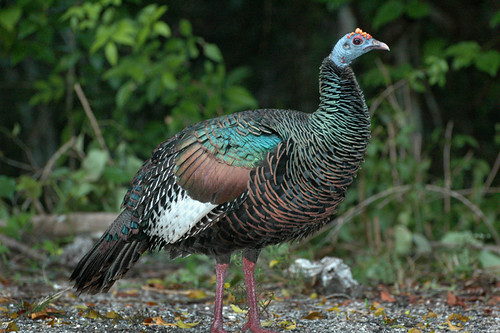tags: birds,Ocellated Turkey, Meleagris ocellata, ornithology, Image of the Day
Ocellated Turkey, Meleagris ocellata,
in the Calakmul Biosphere Reserve in the Southern Yucatan
in the state of Campeche. They are endemic to the region
and are known locally as both Pavo Ocelado or Guajalote Ocelato.
Image: Kevin Sharp. [larger size].
Kevin writes:
The Ocellated Turkey, Meleagris ocellata, is one of only two species of wild turkey. The Ocellated Turkey is near-endemic to Mexico's Yucatan Peninsula. The species' range also extends a bit into Guatemala and Belize, but all total encompasses only some 50,000 square miles.
Known locally as 'Pavo Ocelado' or 'Guajalote Ocelado', Ocellated Turkeys are shy where hunted, but can be very confiding in protected areas, such as Tikal in Guatemala and the Calakmul ruins in Southern Campeche, Mexico. They occupy a range of habitats from forest to pastures and cultivated lands bordered by forest.
Little is known about the Ocellated Turkey. Females are on average considerably smaller than males and males tend to have more pronounced orange nodules on their heads (see upcoming images of the day tomorrow and Thursday to see this feature). Otherwise, their plumage is similar. The birds are largely terrestrial throughout the day as they forage for insects and vegetable matter. They take to the trees to roost at night. Flocks vary from 2 or 3 individuals to 50 or more.
The Ocellated Turkey is listed as near-threatened. They may appear common in some protected areas but are scarce over all. Reasons for the species decline include habitat loss and hunting. The birds are sought after as a food source by local people and are taken as trophies by sport hunters from the U.S. and elsewhere.


Ocellated? Yeah, it does look a bit dizzy.
I never thought to associate the words "turkey" and "beautiful"... but that's a very beautiful bird. Thanks for the picture.